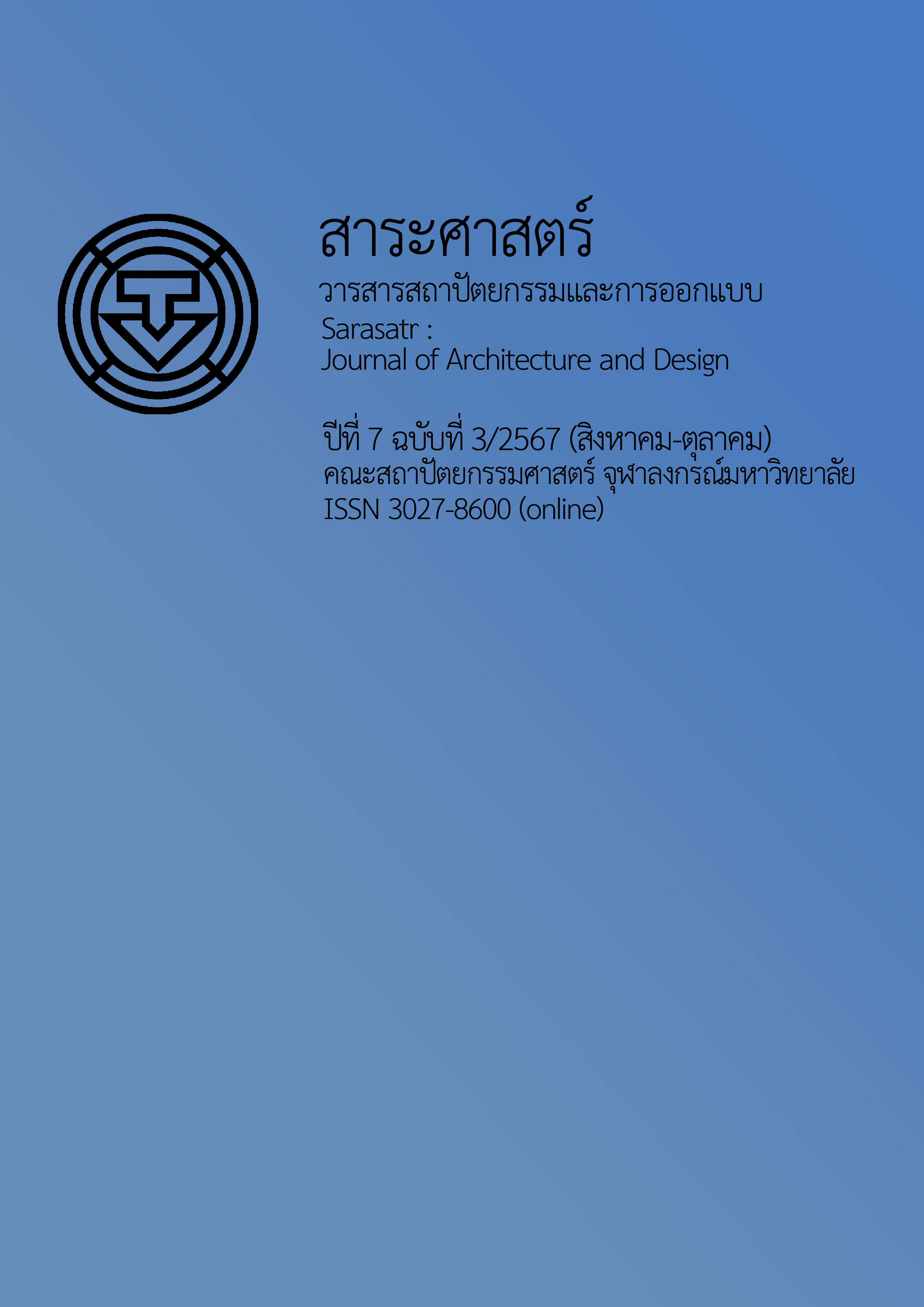Housing Project Management before Establishing a Legal Entity: Case Study of Housing Projects in Bangkok Metropolis and Vicinity
Main Article Content
Abstract
The housing project is a result of residential development, involving the allocation of land for building houses or townhouses and the construction of utilities to facilitate living. There is a clear boundary of the project, both legally and physically. Housing projects differ in terms of project size, house types, market share (segment), common areas, and common fee collection rates. Therefore, the management of housing projects varies accordingly. This article aims to study the physical components of public utilities and the expenses incurred within the housing project (before establishing a legal entity) by collecting information from documents, surveys, photographs, observations, and interviews, followed by a comparative analysis. This will lead to suggestions and guidelines for managing housing projects before and after establishing a juristic person.
The study found that the 18 projects examined offer 16 types of common facilities, which are basic features required in every project. These facilities include entrances and exits, guard rooms, project fences, ornamental plants, project signboards, parking spaces, green spaces, common gardens, streets, walkways, lighting, electrical systems, water supply systems, water drainage systems, water treatment systems, and security systems. The other 9 items are considered secondary utilities because not all projects provide them. These include entrance arch structures, entrance arches, clubhouses, fitness rooms, swimming pools, sports fields, playgrounds, fountains, and ponds.
Furthermore, it was found that in 15 out of 18 projects, income was determined to be unbalanced with expenses. In these cases, income was lower than expenses by -0.92 to -59.04% (representing 0.47-186.23 baht per square wa). In the remaining 3 projects, income was balanced with expenses, with income higher than expenses by +0.08 to +7.78% (representing 0.02-2.31 baht per square wa).
Therefore, it can be concluded that there are 16 essential utilities that must be included in all types of housing projects and market segments. Other elements can be optional, depending on the type of house and market share. It was also found that market segmentation and housing project type are related to the expenses incurred within the housing project (before establishing a legal entity). Projects with higher market segmentation levels generally have higher administrative expenses compared to projects with lower market segmentation levels.
Article Details
References
กชมน แก้วพรหม. (2563). การออกแบบภูมิทัศน์พื้นที่ส่วนกลางที่มีอิทธิพลต่อการตัดสินใจซื้อ โครงการบ้านเดี่ยวในเขตกรุงเทพฯ : กรณีศึกษา โครงการเพอร์เฟคเพลส [วิทยานิพนธ์ปริญามหาบัณฑิต, จุฬาลงกรณ์มหาวิทยาลัย]. Chulalongkorn University Intellectual Repository (CUIR). http://cuir.car.chula.ac.th/handle/123456789/76127
กัญจน์ ทั่งทอง. (2555). การศึกษาปัญหาและสาเหตุของข้อบกพร่องในการก่อสร้างโครงการบ้านจัดสรร [วิทยานิพนธ์ปริญามหาบัณฑิต, จุฬาลงกรณ์มหาวิทยาลัย]. Chulalongkorn University Intellectual Repository (CUIR). http://cuir.car.chula.ac.th/handle/123456789/42507
ข้อกำหนดเกี่ยวกับการจัดสรรที่ดินเพื่อที่อยู่อาศัยและพาณิชยกรรมกรุงเทพมหานคร พ.ศ. 2550. (2550, 23 กุมภาพันธ์). ราชกิจจานุเบกษา. เล่ม 124 ตอนพิเศษ 21ง หน้า 47-63.
ถิรวัฒน์ พิมพ์เวิน. (2562). กระบวนการพัฒนาโครงการอสังหาริมทรัพย์ประเภทที่อยู่อาศัยโดยการมีส่วนร่วม กรณีศึกษา โครงการที่อยู่อาศัยโค-เฮาส์ซิ่ง (Co-housing) และโครงการบ้านมั่นคง [วิทยานิพนธ์ปริญญามหาบัณฑิต, มหาวิทยาลัยเชียงใหม่]. CMU Intellectual Repository. http://cmuir.cmu.ac.th/jspui/handle/6653943832/66283
บัณฑิต จุลาสัย, ยุวดี ศิริ, และวรวิทย์ ก่อกองวิศรุต. (2553). เอกสารวิชาการหมายเลข 5 ภาควิชาเคหการ คณะสถาปัตยกรรมศาสตร์ จุฬาลงกรณ์มหาวิทยาลัยแนวทางการบริหารดูแลหมู่บ้านจัดสรรตามพระราชบัญญัติการจัดสรรที่ดิน พ.ศ. 2543. ภาควิชาเคหการ คณะสถาปัตยกรรมศาสตร์ จุฬาลงกรณ์มหาวิทยาลัย.
บัณฑิต จุลาสัย และเสริชย์ โชติพานิช. (2547). การบริหารทรัพยากรกายภาพ. โรงพิมพ์จุฬาลงกรณ์มหาวิทยาลัย.
ประภัสสร ใจกล้า. (2553). การบริหารชุมชนนิติบุคคลหมู่บ้านจัดสรร โครงการจัดสรรขนาดกลาง กรณีศึกษา หมู่บ้านเบญญาภาราชพฤกษ์ และณัฐชากรีนวิล์จังหวัดนนทบุรี [วิทยานิพนธ์ปริญญามหาบัณฑิต, จุฬาลงกรณ์มหาวิทยาลัย]. Chulalongkorn University Intellectual Repository (CUIR). http://cuir.car.chula.ac.th/handle/123456789/19875
พระราชบัญญัติการจัดสรรที่ดิน (ฉบับที่ 2) พ.ศ. 2558. (2558, 25 กันยายน). ราชกิจจานุเบกษา. เล่ม 132 ตอนที่ 92ก หน้า 15-19.
พระราชบัญญัติการจัดสรรที่ดิน พ.ศ. 2543. (2543, 23 พฤษภาคม). ราชกิจจานุเบกษา. เล่ม 117 ตอนที่ 45ก หน้า 1-21.
ภคพร ช้อนทอง. (2551). การปฏิบัติงานด้านกายภาพและพื้นที่ส่วนกลางของหมู่บ้านจัดสรร หมู่บ้านกรณีศึกษา 30 หมู่บ้านในเขตกรุงเทพมหานครและปริมณฑล [วิทยานิพนธ์ปริญญามหาบัณฑิต, จุฬาลงกรณ์มหาวิทยาลัย]. Chulalongkorn University Intellectual Repository (CUIR). http://cuir.car.chula.ac.th/handle/123456789/21581
เสริชย์ โชติพานิช. (2544). การบริหารจัดการอาคารชุดพักอาศัย : ผู้จัดการนิติบุคคลอาคารชุด. วารสารวิชาการคณะสถาปัตยกรรมศาสตร์ จุฬาลงกรณ์มหาวิทยาลัย, (2), 99-106.
เสริชย์ โชติพานิช. (2553). การบริหารทรัพยากรกายภาพ : หลักการและทฤษฎี. โรงพิมพ์จุฬาลงกรณ์มหาวิทยาลัย.
เสริชย์ โชติพานิช และวัลยา พัฒนพีระเดช. (2559). การจัดการนิติบุคคลหมู่บ้านจัดสรร. โรงพิมพ์แห่งจุฬาลงกรณ์มหาวิทยาลัย.


